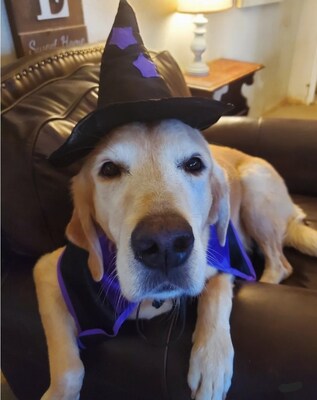A Poisonous Halloween for Pets
Not All Toxic Dangers Are Deadly, But They Are All Scary
MINNEAPOLIS, Oct. 8, 2025 /PRNewswire/ -- Last Halloween, the Ruark family was planning to attend a trunk-or-treat event. Mom Michelle had purchased a large, 90-ounce bag of mini candy bars from Costco, all containing chocolate, and had carefully hidden it inside a shower, behind closed shower doors. They thought they were all set, but their Labrador Retriever Paige had other plans.
Paige had literally knocked the shower doors off their hinges, and had eaten the entire bag of candy, wrappers and all."We don't usually keep chocolate in the house," Michelle Ruark explained. "A couple of nights before Halloween, we came home and found that Paige had literally knocked the shower doors off their hinges, and had eaten the entire bag of candy, wrappers and all." Their first reaction was disbelief, and their second was to call the toxicology experts at Pet Poison Helpline.
"After calculating the amount of chocolate Paige ingested and factoring her weight, we determined she definitely ingested a toxic amount of chocolate," said Dr. Renee Schmid, a senior veterinary toxicologist and director of Veterinary Medicine at Pet Poison Helpline. "Combined with the wrappers, it made for a challenging medical situation."
Based on the amount of chocolate ingested, the Pet Poison Helpline team was concerned about gastrointestinal upset, pancreatitis, polydipsia (excessive thirst), hyperactivity, cardiovascular and central nervous system stimulation.
When Paige got to the Southern Rockies Animal Emergency + Specialty clinic in Colorado Springs, the medical team induced emesis, resulting in a large amount of candy still in the wrappers, chocolate and additional empty wrappers. With the amount of chocolate that was recovered from vomiting, the concern for severe clinical signs lessened and Paige was able to be treated and then sent home to be monitored by her owners.
"Every kind of Hershey bar was in that bag," Roark said. "The Pet Poison Helpline toxicologists looked up every single candy and calculated how much chocolate and other potentially dangerous toxins Paige ingested. By the time we got to the emergency room, they had already talked to our veterinarian and discussed a recommended treatment plan. I know that if we had just shown up at the emergency room, they wouldn't have known how to treat her. Pet Poison Helpline saved our girl's life."
Chocolate is not only number one on Pet Poison Helpline's Top 10 Pet Poisons of 2024, it has been the top toxin for the last ten years. Chocolate contains theobromine and caffeine, which, when ingested in toxic amounts, can result in vomiting, diarrhea, hyperactivity, elevated heart rate, abnormal heart rhythm, tremors, seizures, and possibly death.
"In an emergency, you're not thinking clearly," Ruark added. "It's great to have a toxicologist on the phone with clear steps on what to do, and who will speak directly to our veterinarian about treatment. Fortunately, Paige made a full recovery, but we did not have any chocolate for the trunk-or-treat event."
Although calls about chocolate are the most common, other Halloween cases are spooky fun. Brian Barrett of Philadelphia, Penn., decided he wanted to have fluorescent green water in his annual Halloween display, so he used green trace dye, which glows under black light. The dye is usually used to detect leaks in plumbing and water systems.
"I let my dog Ethan out the night before Halloween, and he drank a small amount out of the display," Barrett explained. "The next day I took him out for a walk and his pee was neon green. The packaging said the liquid was safe, but I called Pet Poison Helpline to be sure. After they heard the details, and researched the ingredients in the dye, they told me what signs I needed to look for and saved Ethan from a trip to the veterinarian. Ethan is doing great."
One of the creepiest cases from last Halloween involved three dogs named Shadow, Gambit and Grimm – oh, and a bat. Lydia Robinson from Maricopa, Ariz., caught Shadow playing with a dead bat in the yard. The other dogs were with Shadow, but only Shadow appeared to have been in contact with the bat. Since all three dogs were current on their rabies vaccinations, and no wounds or bite marks were seen, a trip to the veterinarian was not needed. Robinson was provided with a list of signs to look for, and a suggestion to contact her local health department to see if they wanted to test the bat for rabies.
Finally, one of the greatest dangers facing your pet during Halloween is getting out of the house and into other dangers such as being hit by a car or even stolen.
"According to our partners at AKC Reunite, October is the second highest month for lost-and-found pet reports," Dr. Schmid said. "Pets get anxious from multiple trick-or-treaters coming to the door, and with each visitor you greet, your pet has an opportunity to sneak out and escape the chaos. A loose pet at night is especially dangerous because they cannot be easily seen by motorists."
AKC Reunite, the nation's largest not-for-profit pet recovery service, offers a list of Halloween recommendations for your canine and feline family members. They also partner with Pet Poison Helpline offering its 24/7 toxicology expertise as an optional, unlimited benefit for its members to add to their pet's lifetime protection.
Pet Poison Helpline created Toxin Tails to educate the veterinary community and pet lovers on the many types of poisoning dangers facing pets, both in and out of the home. All the pets highlighted in Toxin Tails have been successfully treated for the poisoning and fully recovered.
About Pet Poison Helpline
Pet Poison Helpline®, your trusted source for toxicology and pet health advice in times of potential emergency, is available 24 hours, seven days a week for pet owners and veterinary professionals who require assistance treating a potentially poisoned pet. Per incident and subscription service options are available. We are an independent, nationally recognized animal poison control center triple licensed by the Boards of Veterinary Medicine, Medicine and Pharmacy providing unmatched professional leadership and expertise. Our veterinarians and board-certified toxicologists provide treatment advice for all species, including dogs, cats, birds, small mammals, large animals and exotic species. As the most cost-effective option for animal poison control care, Pet Poison Helpline's fee of $89 per incident includes follow-up consultations for the duration of the case. The company also offers pethelpline(SM) and pethelplinePRO(SM) subscription services directly to pet lovers. Based in Minneapolis, Pet Poison Helpline is available in North America by calling 800-213-6680. Additional information, including a chat feature for pet owners, can be found online at www.petpoisonhelpline.com.
Contact: Curtis Steinhoff
Pet Poison Helpline®
(602) 300-8466
csteinhoff@petpoisonhelpline.com
![]() View original content to download multimedia:https://www.prnewswire.com/news-releases/a-poisonous-halloween-for-pets-302577451.html
View original content to download multimedia:https://www.prnewswire.com/news-releases/a-poisonous-halloween-for-pets-302577451.html
SOURCE Pet Poison Helpline



